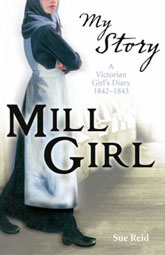|
|
| |
Mill Girl |
In spring 1842 Eliza is shocked when she is sent to work in the Manchester cotton mills – the noisy, suffocating mills. The work is backbreaking and dangerous – and when she sees her friends' lives wrecked by poverty, sickness and unrest, Eliza realises she must fight to escape the fate of a mill girl . . . |
Sue Reid on the background to Mill Girl . . .
Mill Girl was the first 'My Story' I wrote for Scholastic. I loved writing it. It's the imaginary diary of a 19th century mill worker's thirteen year old daughter, Eliza. Telling Eliza's story as a diary really let me close into Eliza's thoughts and feelings. Eliza lives in Manchester, which she absolutely hates. She can see the mill where her father works from her bedroom window and she wishes wishes wishes they could all go back to live in the countryside where her grandfather was born. She has all sorts of dreams and plans for her future, but she is a poor girl, so has to leave school and go out to work to help her family. Eliza rebels against what's expected of her, like any modern teenager might, though the choices for poor people in those days were very limited, and for girls even less.
Eliza was 13 in 1842, the height of what we now call 'the Industrial Revolution'. I'd always wanted to write a story about the Industrial Revolution because it fascinates me. It was a period of exciting and dramatic change - when people who for hundreds of years had always lived and worked in the countryside were forced to find work in the new factory towns which sprang up in the north. At school my teacher had made the subject dreary – long reams of parliamentary acts that we had to memorise. Nothing about the lives of ordinary people, and it was ordinary people I wanted to find out about. I picked the early 1840s because it was a time of hope as well as despair, when workers rebelled against their masters and dreamed of a better future.
Before I could begin writing, I had to do a lot of research. I'd set the book in Manchester, because it was a very important mill town in the 1840s. After reading as much as I could about the period I went up to Manchester to explore the city and try and find out more what it might have been like to have been a mill girl living there in the mid 19th century. I went to an area of the city called Ancoats, which was where a lot of mill families lived crowded together in 'back to back' houses near the factories where they worked. Of course Manchester is a very different city now to the dirty smoky place it was then and it took an enormous effort to see it as my heroine Eliza would have done. However, there were still mills in Ancoats – huge empty buildings, some of the earliest mills ever built. I walked round the quiet rooms and tried to imagine them filled with big noisy spinning machines and weaving looms. But to see a working factory I had to go north of Manchester, to a place called Helmshore in Lancashire. In the weaving shed a few looms were turned on to give me an idea how noisy it would have been. Even with just a few looms running the din was tremendous – if you try and imagine a million knitting needles or typewriters clacking away it will give you a tiny idea what it was like.
In the spinning room I saw how scary it must have been for a child crouching under a spinning machine ready to snatch up the waste, and how tiring and boring the work must have been – hour after hour in a hot and dusty room.
You can visit some of the places I did to find out what life was like for a family like Eliza's. Here are some suggestions: Helmshore Textile museums, Helmshore, Lancashire, and Quarry Bank Mill, Styal, Wilmslow, Cheshire. In Manchester there are some excellent museums where you can find out about the machines that were transforming people's lives and industry, and get more of an idea what it was like to be alive at that time. Try the Museum of Science and Industry, and the People's Museum. |
|
|
 |
Publisher: Scholastic
Language: English
ISBN-10: 1407103733
ISBN-13: 978-1407103730
Order from Amazon |
"Sue Reid's Mill Girl ... (is) particularly good - packed with feeling as well as convincing historical detail."
The Independent |
|
|
|
Monday 23 May 1842
Am so tired, I can scarcely bear to write at all, and my legs and arms ache so much. Mother took one look at me, when I came through the door this evening and told me to go upstairs to rest. But I wouldn't, not until I'd cleaned away the dirt - the fluff that still clung to me, the oil staining my hands and feet. Afterwards, I must have fallen asleep because I awoke to find someone shaking my shoulder and I was terrified it was morning again. But it was only Mother, waking me for supper. I followed her downstairs but I could hardly get anything down. Those big machines still haunt me. I had to stand behind them and watch the slivers of cotton unreel into the large cans. They're four feet tall – nearly as big as me. My hands were shaking so much at first that I thought I'd drop them. And the endless sweeping and cleaning. And all the time, longing to sit down – even for a minute. And that smell of oil and sweat, and the fluff that gets into the water and even on to your food. But worst is knowing that tomorrow I'll have to go there again. |
|
 |